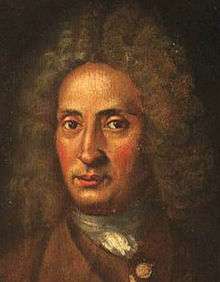Giuseppe Torelli

Giuseppe Torelli (22 April 1658, Verona – 8 February 1709, Bologna) was an Italian violist, violinist, teacher, and composer.
Torelli is most remembered for contributing to the development of the instrumental concerto (Newman 1972, p. 142), especially concerti grossi and the solo concerto, for strings and continuo, as well as being the most prolific Baroque composer for trumpets (Tarr 1974).
Life
Torelli was born in Verona. It is not known with whom he studied violin though it has been speculated that he was a pupil of Leonardo Brugnoli or Bartolomeo Laurenti, but it is certain that he studied composition with Giacomo Antonio Perti (Schnoebelen and Vanscheeuwijk 2001). On 27 June 1684, at the age of 26, he became a member of the Accademia Filarmonica as suonatore di violino (Schnoebelen and Vanscheeuwijk 2001). On 1687 Giuseppe Corsi da Celano, played Torelli's music, from Op. 3, in Parma at the Sanctuary of Santa Maria della Steccata.(Ciliberti and Tribuzio 2014) By 1698 he was maestro di concerto at the court of Georg Friedrich II, Margrave of Brandenburg-Ansbach, where he conducted the orchestra for Le pazzie d'amore e dell'interesse, an idea drammatica composed by the maestro di cappella, and the castrato Francesco Antonio Pistocchi, before leaving for Vienna in December 1699. He returned to Bologna sometime before February 1701, when he is listed as a violinist in the newly re-formed cappella musicale at San Petronio, directed by his former composition teacher Perti (Schnoebelen and Vanscheeuwijk 2001).
He died in Bologna in 1709, where his manuscripts are conserved in the San Petronio archives. Giuseppe's brother, Felice Torelli, was a Bolognese painter of modest reputation, who went on to be a founding member of the Accademia Clementina. The most notable amongst Giuseppe's many pupils was Francesco Manfredini.
Selected works
- 10 Sonate a 3, with basso continuo, Op. 1 (1686).
- 12 Concerto da camera, for 2 violins and basso continuo, Op. 2 (1686).
- 12 Sinfonie, for 2–4 instruments, Op. 3 (1687).
- 12 Concertino per camera for violin and cello, Op. 4 (1688).
- 12 Sinfonie a 3 e concerti a 4, Op. 5 (1692).
- 12 Concerti musicali a quattro, Op. 6 (1698).
- 12 Concerti grossi con una pastorale per il Santissimo Natale, Op. 8 (1709).
- More than 30 concertos for 1 to 4 trumpets, including a Sinfonia à 4, composed after 1702 (Tarr 1974) and unpublished during his lifetime, which is a concerto for four trumpets, with an orchestra requiring a minimum of four oboes, two bassoons, trombone, timpani, four violins, two violas, four cellos, two double basses, and continuo.
Sources
Francesco Passadore, Catalogo tematico delle composizioni di Giuseppe Torelli (1658 - 1709), Padova, Edizioni de I Solisti Veneti, 2007, ISBN 88-901412-6-3.
- Newman, William S. 1972. The Sonata in the Baroque Era. New York: W. W. Norton.
- Schnoebelen, Ann, and Marc Vanscheeuwijk. 2001. "Torelli, Giuseppe." The New Grove Dictionary of Music and Musicians, second edition, edited by Stanley Sadie and John Tyrrell. London: Macmillan Publishers.
- Tarr, Edward H. 1974. Unpaginated editorial notes to his edition of Giuseppe Torelli, Sinfonia a 4, G. 33, in C major. London: Musica Rara.
- Ciliberti, Galliano, and Giovanni Tribuzio. 2014. "'Un buon virtuoso, agitato dalla fortuna, dalla quale sortì vari accidenti'. Giuseppe Corsi: un maestro marsicano nel Seicento europeo". In "E nostra guida sia la Stravaganza": Giuseppe Corsi da Celano musicista del Seicento, edited by Galliano Ciliberti and Giovanni Tribuzio, 43–45. Bari: Florestano.
Further reading
- Bukofzer, Manfred F. 1947. Music in the Baroque Era: From Monteverdi to Bach. New York: W. W. Norton.